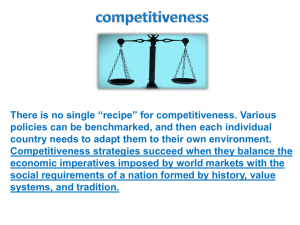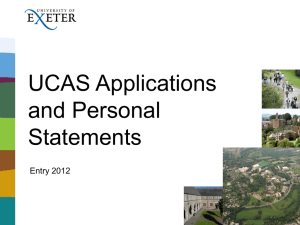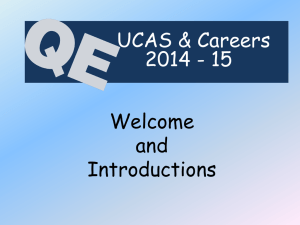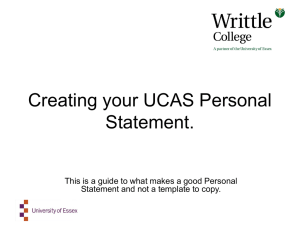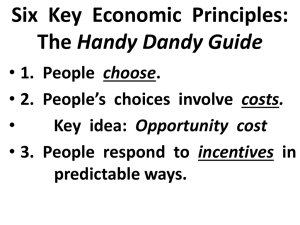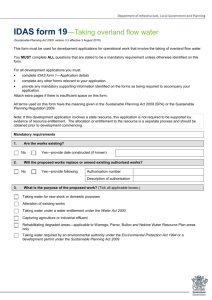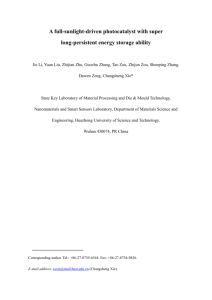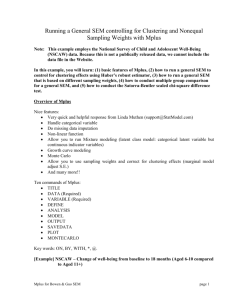Handy Guide to Implementing A Level Reforms
advertisement
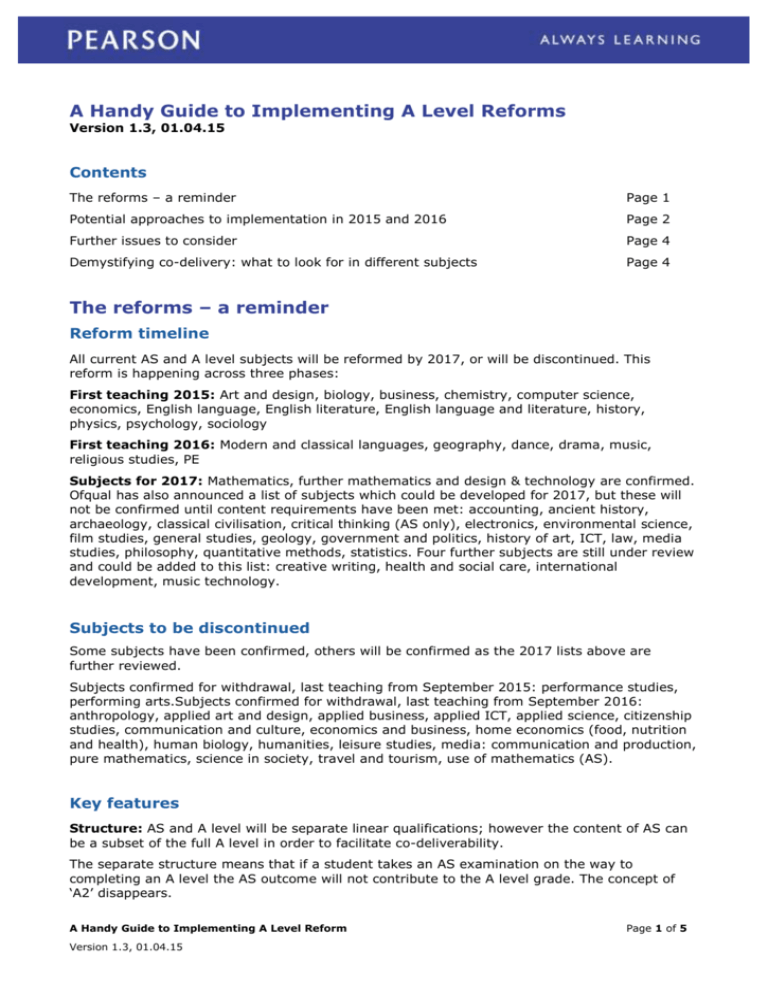
A Handy Guide to Implementing A Level Reforms Version 1.3, 01.04.15 Contents The reforms – a reminder Page 1 Potential approaches to implementation in 2015 and 2016 Page 2 Further issues to consider Page 4 Demystifying co-delivery: what to look for in different subjects Page 4 The reforms – a reminder Reform timeline All current AS and A level subjects will be reformed by 2017, or will be discontinued. This reform is happening across three phases: First teaching 2015: Art and design, biology, business, chemistry, computer science, economics, English language, English literature, English language and literature, history, physics, psychology, sociology First teaching 2016: Modern and classical languages, geography, dance, drama, music, religious studies, PE Subjects for 2017: Mathematics, further mathematics and design & technology are confirmed. Ofqual has also announced a list of subjects which could be developed for 2017, but these will not be confirmed until content requirements have been met: accounting, ancient history, archaeology, classical civilisation, critical thinking (AS only), electronics, environmental science, film studies, general studies, geology, government and politics, history of art, ICT, law, media studies, philosophy, quantitative methods, statistics. Four further subjects are still under review and could be added to this list: creative writing, health and social care, international development, music technology. Subjects to be discontinued Some subjects have been confirmed, others will be confirmed as the 2017 lists above are further reviewed. Subjects confirmed for withdrawal, last teaching from September 2015: performance studies, performing arts.Subjects confirmed for withdrawal, last teaching from September 2016: anthropology, applied art and design, applied business, applied ICT, applied science, citizenship studies, communication and culture, economics and business, home economics (food, nutrition and health), human biology, humanities, leisure studies, media: communication and production, pure mathematics, science in society, travel and tourism, use of mathematics (AS). Key features Structure: AS and A level will be separate linear qualifications; however the content of AS can be a subset of the full A level in order to facilitate co-deliverability. The separate structure means that if a student takes an AS examination on the way to completing an A level the AS outcome will not contribute to the A level grade. The concept of ‘A2’ disappears. A Handy Guide to Implementing A Level Reform Version 1.3, 01.04.15 Page 1 of 5 Assessment model: Assessment will normally be by examination only, except where nonexamined assessment is the best approach. Availability: Assessment will be available only in the summer. Grading: The new A and AS levels will continue to be graded from A to E, with an additional A* grade available at A level only. The new A levels will require a new approach to calculating A* grades. Standards: The standard of AS will remain in line with current end of first year standard; the A level standard will remain in line with current A level standard. Potential approaches to implementation in 2015 and 2016 In 2015 and 2016 there will be a mix of ‘new’ and ‘legacy’ A levels available. This may require a different strategy compared to that which might be adopted in 2017, when all subjects will be linear with a decoupled AS. Also by 2017 schools and colleges will have had two years’ experience of the new qualifications, and will be able to make informed decisions about how to continue. This list is not exhaustive, all models can be further varied in different ways, and not all models will be appropriate for all schools or colleges – but all are possible. Some of the pros and cons of each model are suggested. Treat all students as if they are on ‘old’ A levels: Students opt for four subjects irrespective of whether they are choosing ‘legacy’ or ‘new’ subjects. All students take AS exams in all subjects at the end of Y12, and decide which three they will carry on with to full A level. + No confusion for students about whether they should take AS or not. + Students can defer choosing which subjects to commit to at A level. + Students and / or school / college can make informed decisions about Y13 study. + Students will have an AS result for whichever subject they drop. + Replaces school-set end of year exams – reduces school workload and increases importance of the exams. + Students have a full set of AS results to include on UCAS application forms. + AS results in ‘new’ subjects will not contribute to the A level grade, but will be a valuable progress check for school and student. - If co-delivering AS and A level, Y12 teaching would need to be focused on AS course content; if delivering linear A level only, the content could be apportioned differently over the two years. - Co-delivery could mean all Y12 / AS content needs to be delivered at full A level standard. - Y12 teaching finishes early to take account of AS timetable. Can school / college continue A level teaching after AS exam weeks? - Additional cost of entering students for AS and A level (new subjects only). A Handy Guide to Implementing A Level Reform Version 1.3, 01.04.15 Page 2 of 5 Four subject model but with AS confirmed up front: Students opt for four subjects, at least one of which has separate AS and A level classes, or has AS and A level co-delivered (or is still AS/A2). They are entered for one AS only, in the subject they intend to drop. + Breadth of study is maintained through the fourth subject offer. + There are no double entry costs (AS plus A level). - Only one AS result is available for UCAS application forms. - Choices are made up front, so no opportunity to use AS results to select best 3 subjects from 4 for Y13 study, and have an AS result in the fourth. - Can potentially still change mind about the three to continue with at the start of Y13, but would have no AS in the subject dropped, and might have missed some teaching in Y12 by studying AS only. Treat all students as if they are taking new linear A levels: Students opt for three subjects and study them in linear fashion whether they are new linear subjects or old AS/A2 subjects + No confusion in school or college – all subjects run to the same approach. + No additional AS entry costs for new subjects. - No opportunity for students on AS/A2 subjects to resit the AS element in Y13. - No AS results for UCAS application forms. - No option for a fourth complementary AS subject. - No opportunity to select best 3 subjects from 4 for Y13 study. Offer each subject in the format available: Students can choose three or four subjects. New subjects are delivered as linear A levels. Students can choose a fourth AS only in a legacy AS/A2 subject, or in a new subject if there is a separate AS class. + Clear offer to students regarding the subjects in which AS can be chosen. + No problems with trying to co-deliver AS with linear A level. + No additional AS entry costs for new subjects. - Limited AS offer for students. - Possible incentive to choose AS/A2 subjects over ‘harder’ linear subjects. - Limited opportunity to select best 3 subjects from 4 for Y13 study – may be no opportunity for some. - Limited AS results for UCAS application forms. A Handy Guide to Implementing A Level Reform Version 1.3, 01.04.15 Page 3 of 5 Further issues to consider The phased introduction of the new qualifications means that for two years (2015 and 2016) there will be cohorts starting where some students are taking all linear subjects, some are taking all AS/A2 subjects, and some are taking a mix. Schools and colleges might want to adopt one approach for this transition phase, with a view to changing once all subjects are linear. Does there have to be a single whole school / college approach, or can decisions about AS be left to individual departments? Parent / student expectations – there will be a range of expectations, perhaps particularly from those families where older siblings have gone through the AS/A2 approach. If school policy is no AS, and a parent offers to pay for their son / daughter to take the AS – what does that mean for equalities? Local competition – what are other schools and colleges in the neighbourhood offering? The new UCAS tariff gives AS only 40% of the points for an A level (effectively a 20% reduction on current value – what impact will that have on their value for HE admission? Ofsted expectations in relation to the implementation of study programmes – programmes should be designed to meet learners’ needs and aspirations, and a single ‘one size fits all’ may not be appropriate. What will the general election bring….? Labour has indicated they intend to reintroduce an AS/A2 approach, but Ofqual has warned that this will not be quick or easy. Demystifying co-delivery: what to look for in different subjects If you are considering a model where AS and A level students are taught in a single group, there are two key factors to consider when making decisions: Co-delivery and its practical implementation will vary across subject types. Within a given subject, awarding bodies have not necessarily approached this issue in the same way. Ofqual has stipulated that AS and A level need to be assessed at a different standard. What this means in practical terms has a bearing on how co-deliverable a specification really is. It will look different in subjects where the standard is defined by how demanding the content is, to subjects where the difference in standard relates to the expected skill level of the student. The following are some illustrative examples from different subjects that may help when making decisions about specifications. Biology, Chemistry, Physics, Business, Economics and Psychology: In these subjects, it is possible to design specifications where the content builds conceptually over the two years. The Year 1 content can be taught in exactly the same way whether leading to an AS exam or as the first half of an A level course. The Year 2 content builds on the Year 1 material, both in breadth and in depth. Effectively, Year 1 provides the building blocks, and Year 2 deepens student understanding. For the A level assessment, the Year 1 content is drawn down upon as assumed knowledge for this application, and will be assessed within the context of greater holistic understanding at the A Handy Guide to Implementing A Level Reform Version 1.3, 01.04.15 Page 4 of 5 end of the course. It does not therefore need to be ‘revisited at a different standard’ in Year 2, taking up Year 13 teaching time. English Literature: Here, the thing to look out for is text choice. The most co-deliverable specification will be the one where the choices of set texts for AS are exactly the same as Year 1 of an A level course, and the assessment mode is the same (i.e., candidates are not expected to sit an exam on texts for AS, and then have to use them for coursework at A level). Some specifications may proffer AS texts as a subset of the full A level options – making co-delivery viable but potentially limiting choice. The Year 1 texts will of course be revisited at the end of Year 13 as part of revision, but the increase in standard comes from the skill development and increased maturity that the candidates have acquired over the two-year course. They will not need to be taught in a different way. History: Here, the AS content can be the same as the A level Year 1 content. The difference in the standard will be in the complexity of the questions and in the expectations of the mark schemes. The key to making the qualifications co-deliverable in History is in: the weightings of the components, with the AS content half of the A level having a common structure and skills targeting in the exam papers (e.g. not assessing a skill in one paper at AS that isn’t assessed in the equivalent paper at A level) ensuring progression in the questions and mark schemes from AS to A level, allowing the AS to be used as a stepping stone to A level, building on candidates’ skills development over the two years. Art: It was initially thought that art would pose more of a co-delivery challenge, because work submitted for AS assessment could not be resubmitted as part of an A level portfolio. However it has now been confirmed that work submitted for AS level art and design can form part of a student’s submission for A level art and design. Nevertheless, It is important to bear in mind that the A level standard is higher than the AS level standard, so the performance expected of students at A level is different to the performance expected of students at AS level, and that any AS level work that forms part of an A level submission will be assessed at the A level standard. A Handy Guide to Implementing A Level Reform Version 1.3, 01.04.15 Page 5 of 5

